#I COULD GO ON ABOUT HOW PURGE MARCH TREATS ITS FICTION BUT THAT WOULD MAKE THIS SO LONG-
Explore tagged Tumblr posts
Text
Magic as a TV Show
(CWs: Child Abuse, Cults) (Edit: Did some light editing, still a bit messy but should be fine now)
So, it's not a secret that I'm a big fan of Magic. It's my favorite T1 MV and one of my favorite Milgram MVs in general. Even before Purge March I'd re-watch it over and over again just because I liked it so much.
One of my favorite things about it is the way the visual language and symbolism develops over it's runtime, and with Purge March it's gotten ever better so lets talk about it!
Based on True Events
So, Magic is the very cheery TV Show that is based on the horrors going on backstage, and it's also aware of it's own fictional nature. It ends with the real Amane watching the show. It knows it's a world created by a 12 year old who wants to be Good.
This causes something interesting when viewing it's imagery. As Magic depiction of events can be both very literal and very metaphorical at the same time.
For example: Something that surprised most people (including myself) is the cat being real, and while it is representative of Something (which we will get to) it is very much an actual cat that was killed.
Magic plays with what is real and what is fictional very loosely, and while certain things Happen in the real world, you can't really separate the real from the fictional here. It's too interconnected with each other and the imagery would lose it's impact if you did separate them.
So with that established it's visual analysis time!
The Set

So Magic is set in one place for the majority of it's runtime. This set! Which resembles a lot of educational kid's tv programs, usually ones for preschool and under.
Here's are sets from an early season of Hi-5 and Imagination Movers to compare.

You can see the similarities, it's heavy on bright colors and wacky designs, the logo of the show is plastered Somewhere you can easily see, and only some of the props can actually be used!
These two examples are also very music based. Both of them being shows starring children's musical groups.

The animals here (except for the Cat which is in a Complicated situation) are probably representative of the audience. The other people of the cult being taught along with Amane.
Audience Participation is a big thing for shows like this, you'll see them perform with a bunch of children on the side cheering and dancing. It's a fun time for everyone!
Going back to the set, while the main set only has the colorful stage we do see a few props in Magic. You can see a Choir book right here so the group can sing.

A Whiteboard to teach.

A Donation box to show your generosity.
And...

A Game Show Stage to see if you understood the lesson.
Age Rating
I've talked...extensively before on how Pain is handled in Magic and while that post is outdated because I posted it right before Purge March a lot of it still stands to some extent.
Amane's pain in Magic is downplayed in Magic, it's nothing serious. Even though this pain is something Inflicted Onto Amane Physically by Gatacha.
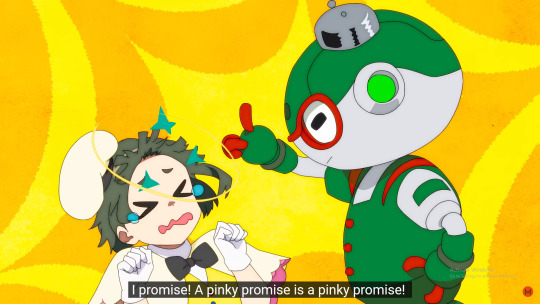
I was going to talk a bit about corporeal punishment in Japan before realizing that this isn't even something that is considered a punishment. It's just a finger flick. This is something your older brother does to you cause he thinks its funny. It's the lightest possible kind of "punishment" there is.
This makes Amane's reaction to it seem silly. An Overreaction to something that isn't even that bad. She has cartoonish swirls and falls over dramatically. It's...Immature of her to react like this.

Even though we know these are injuries are much more serious than they are shown here. Magic doesn't portray them as serious, and also portrays Amane as Immature for acting like this.
Which points to something interesting, as I said this show resembles a preschool show and it's strange that twelve year old Amane Momose, almost a teenager Amane Momose, is existing in a world like this.
It gets even weirder when we consider that, while Amane most likely hasn't been exposed to much media her mind still conjures up a marching band in Purge March and she talks very "adult" in both her VDs and hates it when people treat her like a child.
Not only that, but Amane Momose in both Purge March And Magic is drawn visibly older than she actually is.

It's not the easiest to see because I can't find a good picture but you can see it in just the face shape. Outside of Magic and Purge March Amane's face is more squishy, with less defined cheeks and bigger, rounder eyes. While Magic and Purge March have her face be more defined and her eyes smaller and sharper. Making her look more like a young teenager rather than the seven year old. She's even called Big Sister Amane in Magic's credits.
If Amane Momose's mind is depicting her as older than she actually is, and Amane Momose outside of it acts very "adult" and hates it when people treat her like a child. Why then does Magic portray her actions as immature? Why is she put in the spot of a preschooler learning from their teachers?
Why is Amane Momose, in her mind, stuck in a preschool show?
Well, there's two layers to this.
First of all, Good preschool shows are usually very empathetic to the kids watching them and good preschool shows don't patronize or talk down to the viewers.
Even if the problem is seemingly irrational or nonsensical.
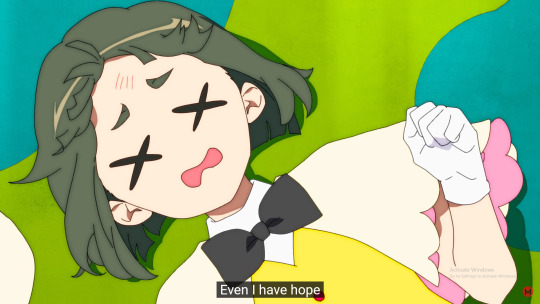
It's important to be empathetic with your viewers.
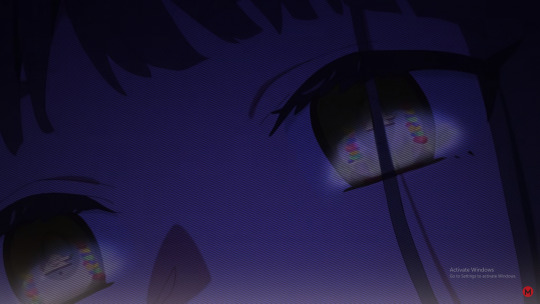
And to treat it their problems and issues with respect and understanding.
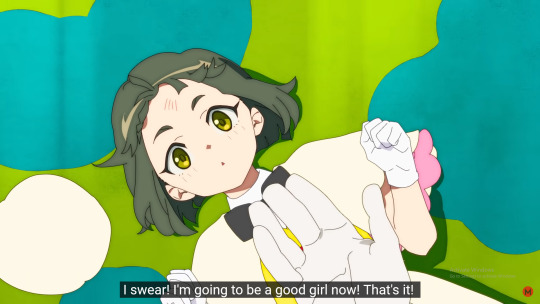
A concept that would be very appealing to Amane Momose, person who gets tortured for even showing a smidge of "impurity."
Second, why...wouldn't Amane Momose be portrayed as the preschooler learning here? She's the one constantly messing up, still not a good girl even though she should have learned by now. She's immature by the standards of her cult.
She's the perfect actor for this role, a girl that cannot be a good girl but wants to be.
Only if, only if, only if I could be a good girl I hope, I hope everyone can be happy and smile Forever, forever together would be a dream
The big sister that everyone can learn from, a character who has to learn from the older more experienced folk in the cast before becoming like them. The one who fails so that everyone else can learn.
This is the role Amane Momose has given herself.
Well...that and one other thing.
Cast

Will I ever get over the cat parallels?
The answer is no, but ignoring that, Amane has gotten two acting roles! The cat here is both the actual Purge March cat but is representative of Amane. As seen by how the injuries on the cat are her injuries in Magic and Purge March and how the cat gets directly paralleled with her in shots. This cat is, for all intents and purposes, both The Cat and Amane.
This gives the scene where Amane helps the cat a neat double meaning. Amane is helping the cat but it's also symbolically her helping herself...and failing.
Because Your not supposed to escape your trial.
Amane: Both pain and illness are trials.
This is one of the worst things you can do.
Amane: According to our teachings, those who run from them are the worst evil there is. That’s one of the four great principles. No matter who you are, that cannot be forgiven.
Your especially not supposed to steal those trials away.
Amane: Oh – speaking of which, there is one among the prisoners right now. An evil existence that’s trying to steal people’s trials away from them.
The cat is Amane's sinful desires to escape pain and help people, because that's Bad Apparently. She is cast as both the sinner and the thing that tempts people to sin. The corruptive force and the one who falls for it.
If were talking TV: She's the one in those 90s PSA episodes who gets Wrapped up in a Bad Thing and also the person who's the gateway to the Bad Thing.
(Blueepink has a wonderful addition to one of my posts over here which elaborates on this and is what made me realize it in the first place. Go read it she talks about some fun animal symbolism in it!)
Amane does however redeem herself in the end. You can always learn to be better after all. Even if you are the Worst Girl.

But you can't get rid of the devil that easily, she had some help!
(You can't get rid of the devil that easily in general, but it's nice to imagine you could-)
Let's talk about the mascots!
And Crew
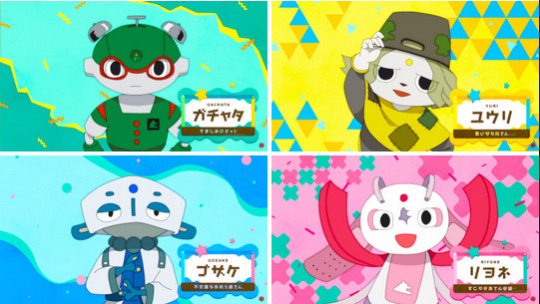
So as people have noted each mascot corresponds to one of the doctrines.
In Magic introduction order we have:
Gachata- ’Tis ordained, thou shall stay thine course, then perish Yuri- ’Tis ordained, thou shall deliver unto those thou believest in Gozake -’Tis ordained, thou shall discard vulgarity Riyone- ’Tis ordained, thou shall follow thine destiny
(Fun fact: The doctrines are introduced opposite to how the mascots are introduced in Purge March. I don't know what this means but it certainly is interesting)
Like a lot of children's tv show groups, each mascot seems to be focused on a specific task/idea.
Gachata is Teaching Yuri is Donations Gozake is Choir And Riyone is Complicated
Each design reflects this in one way or another. Gachata is a robot because robots are associated with being smart and logical. Yuri's clothes are patched up and he's wearing a bin making him look, well poor. Gozake is in priest's wear and has a Conductor's Baton and Riyone...
Well, she has bandage ears. But that's a weird design choice isn't it? Especially since the cult is so against medicine, or more accurately against escaping pain, that Wrapping a Handkerchief around a cat's leg is considered wrong.
Amane literally wants to kill Shidou Right Now for violating that rule...so why does Riyone have bandages?
The answer is she doesn't, this is Magic Exclusive Design Choice.

Here is the best picture of Riyone I Could get in Purge March.
These are not the same ears, their rounder and smaller and don't have the bandage holes at the end.
Do you know what else is weird about Riyone?

This sequence.
Because as Amane has stated in the T2 VD, your not supposed to run from pain.
So why is Riyone suggesting healing the cat's physical injury through prayer?
Especially since, presumably, the rule about pain is under her. She's the one representing it.
Well, this is Amane's fictional TV show. The one she's writing to bring herself comfort. Why Wouldn't she want Riyone to be a healer who could stop the pain?
You will note that this gives extra responsibility onto Amane for not following what is the obvious Good Action. Healing the Cat with Prayer would have Fixed everything but she had to go Too Far and needed to be taught a Lesson and now the cat is Gone.
Riyone is also paralleled with her mom.
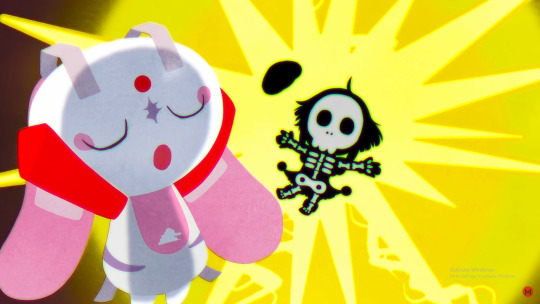
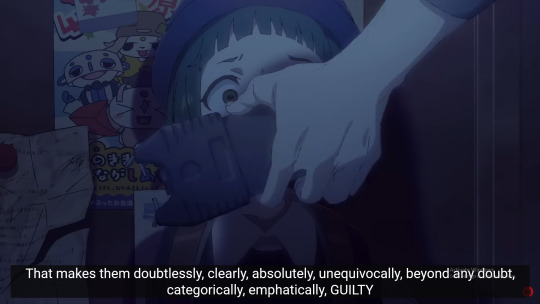
This is probably due to the rule she's associated with, as that's the rule her mom punished Amane for breaking and the rule Amane punished her for breaking.
Amane has Not acknowledged that what was done to her was Wrong, she has just acknowledged the hypocrisy of the action. Riyone is portrayed as right for punishing her since it Is her doctrine she broke, while her mom is portrayed as wrong because she was not able to live up to her own standards.
This is probably why Riyone doesn't disappear in the end. As said above, Magic plays very fast and loose with what is real and what is metaphorical. Riyone represents her mom Yes but She's more representative of the rule, a rule that Amane still (wants to) believe in it.
For now at least.
Lighting
So I haven't mentioned the stage light yet even though it's a really important part of it, it's what sets off the chain of events that end in Winged Amane. It's the most real looking thing in this entire MV.

In a move I will find funny forever, this is one of the few things in Magic that doesn't seem to be connected to any specific real world event, object, or person. This stage light is most likely, purely a metaphor.
The way it disguise its nature is really interesting to me. Magic is so obviously fictional and fantasized that the real looking stage light stands out, especially since it hurts The Cat. It's unexpected and concerning, it feels out of place in this cheery world.
Except, I've mentioned it multiple times now that Magic plays fast and loose with the boundaries of fiction and reality. Magic is a show and it knows it. This Stage light was always apart of it's visual identity as a show.
This Stage light is the most obvious Show element out of everything. It's the lighting AND the inciting incident. An important backstage element and an important story element all wrapped up into one light.
This is also probably a reference to an early scene in the Truman Show.
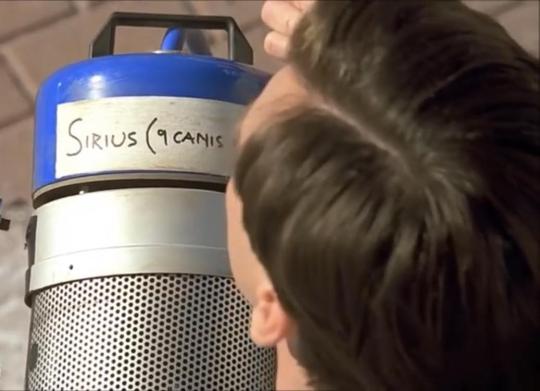
The light falling is one of the first things that clues Truman to the nature of his world. It's the inciting incident because Truman starts noticing more strange things happening in his town, and an important backstage element, a star in the sky.
Plus, the stagelight was already breaking when we see it in Magic, we can see it flicker for a few seconds before falling.


It wasn't sabotaged with the intent to hurt. The light of this world is Literally Breaking. This image of stable happiness was never going to last forever and has probably been broken multiple times in the past.
It just so happened that The Cat was the one it fell on-top of this time.
Audience
I would go into more costuming or the storybook sequences in Magic if this post wasn't already so long. I think Magic is a deeply interesting MV and honestly it doesn't even feel like I'm scratching its surface sometimes.
I sometimes call it Amane Momose's self-insert hurt/comfort fix-it-fic because that really is what Magic is. It's her fix-it fic. Her TV series. Her maladaptive daydream that makes her feel like she still Has Something to hold onto.
Even I can say "I'm sorry" Even I have hope I swear! I'm going to be a good girl now! That's it!
This is actually something she shares a bit with Fuuta but if we talked about those parallels we would be here forever and it's also very much out of the scope of this post.
But, as I mentioned, we see Amane watching it at the end. She's an audience member for her own show, detached from all the silly, empathetic, understanding, fun events going on in that world.
Amane Momose is Very Aware that the world she wants isn't real.
But even so, that Want for it to be real is going to bleed into everything.
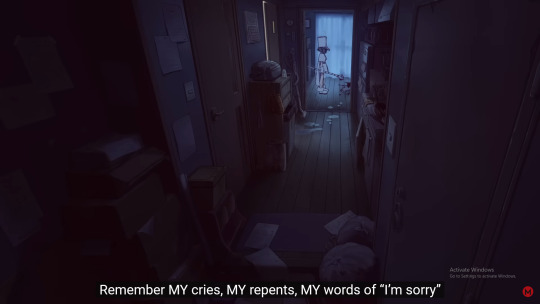
#milgram#amane momose#008#milgram amane#milgram meta#milgram analysis#cw child abuse#cw cults#I COULD GO ON ABOUT HOW PURGE MARCH TREATS ITS FICTION BUT THAT WOULD MAKE THIS SO LONG-#SOMETHING SOMETHING 'IN PURGE MARCH THE FICTION BLEEDS INTO REALITY!' SOMETHING#ITS INTERESTING BUT I WANT THIS OUT OF MY DRAFTS ITS BEEN HERE FOR A WEEK#ALSO I CONDONE THIS MURDER BTW I THINK SHE SHOULD OF KILLED EARLIER-#IM JUST SAYING THAT THE FICTIONAL AMANE IS INDICATIVE OF A DEEPER ISSUE HERE#LIKE THE ACT OF VIOLENCE IS SOMETHING SO CATHARTIC THAT AMANE CANT IMAGINE IT AS SOMETHING SHE DID-#im not writing the post in the tags here
56 notes
·
View notes
Text
Air Date: 12th March 2018 Director: Alan Taylor Writers: Kalen Egan, Travis Sentell, Philip K. Dick.
Story.
A single car drives through an old decaying urban area, leading to a bridge that shows an advanced city skyline. In the car are Irene Lee Maura Tierney and her daughter Foster Annalise Basso who have travelled from a low-tech bubble in the west to discuss some of the invasive procedures this advanced society seem to be involved in. As wonderful as this utopia looks, Irene is pretty sure that the freedom of the people is far more important. Foster, on the other hand, seems to be impressed with what the city has to offer.
The next day Foster attends school for the first time and already alarm bells are ringing as she enters the building, only because she isn’t wearing a DEX, a tech bracelet and tracking device. Foster is pulled to one side, searched and assigned a red band for her arm. In class, she starts to understand how different she is from the other students and realises some actually fear her. Before she leaves, Kaveh Algee Smith a student says he can get her a DEX if she really wanted to fit in with the others.
Back home, Foster tells Irene about the DEX and she refuses to let her daughter have one, there is a difference between safety and comfort and Foster would be giving up her freedom with this device. Foster, has different plans and the next day she asks Kaveh to get her a DEX bracelet using her mum’s credits. Once the purchase has been made, Kaveh goes to kiss Foster and she declines, saying she only wanted his help! Kaveh takes offence and tells Foster to wait on her own for the DEX. Foster waits and eventually, a delivery drone appears and drops the device to the ground, before taking the box home. As Foster opens the box, she is asked to put a device into her ear (Hear Gel) and put on a bracelet which then opens up a holographic display. Struggling to close the DEX down, Foster starts to hear a voice, its customer support. An employee for the DEX kindly takes her through the tutorial of the bracelet, also telling her she is a natural. Foster asks the employee his name but he says it’s against company policy to disclose such information and the chat ends.
In school, the next day the students are watching a video of a terrorist attack and the teacher asks one of the students to point out who the suspect is? Foster notices a man in the crowd who is wearing a badge from her bubble and before she has a chance to tell anyone, it’s him who ignites the bomb! The video says that the terrorists used mind-control on this suspect. Things go from bad to worse for Foster as she finds out Kaveh is about to ruin her because she didn’t have sex with him the day earlier. In order to put things right, she offers herself to him and he declines. Foster has a panic attack and runs to the toilet and as she becomes more upset, the voice from customer support is back again. He says that her vitals are going through the roof and he is worried about her, then he offers to help her situation by looking into Kaveh’s background. It’s not legal, it’s just a favour, he also reveals his name is Ethan Connor Paola.
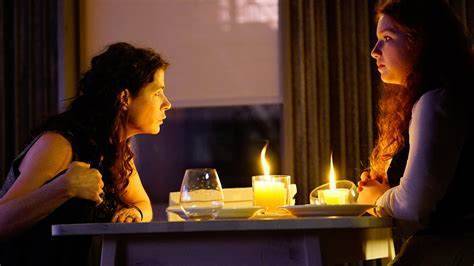
Breaking news a terrorist attack has been stopped in the city!!! Irene is in the middle a video link discussion with a government official when Foster returns home, she believes the attack is a set up by the government because of her presence there. Ethan contacts Foster again but he sounds startled this time. Ethan believes Kaveh is up to something far suspicious after looking into his DEX, he asks Foster for her help and will she follow him before he can go to his boss with any evidence and she agrees. As Foster is following Kaveh through the school and talking with Ethan, a concerned student walks up to her and ask’s if she is okay, only because she is talking to herself? Foster explains that it’s her Hear Gel, but the student looks confused and walks away. Ethan says that she is one of the first people to use that technology but he suddenly changes the subject by telling Foster she has a new target now, it’s Milena Alice Lee a girl who she first met at the school. Foster follows Milena which eventually leads to a library containing real books, something this society doesn’t appreciate anymore as everything is digital. Foster asks Milena about Kaveh and what they get up to together but Ethan says she is lying, which causes her to have another panic attack. Milena calms Foster down by giving her a drink and telling her about her family background. Ethan starts to scream into Foster’s ear, she must go to the bathroom and purge herself, the drink she had could be poison. Ethan now believes something bigger is going on at the school and it’s now Milena’s father who is the target. Ethan says she cannot trust anyone now, including her own mother, who finally comes to pick her up from school. In the car, Irene confronts her daughter about her breakdown and what is going on. Irene also mentions Foster’s father which causing more hostility and anxiety between the pair just as Foster’s DEX lights up in front of them. Irene says that the DEX would have been paid for with her verified credits and that’s what this mess could all be about, as the car drives away, the bracelet drops out of the car window.
Annalise Basso as Foster Lee
PHILIP K. DICK’S ELECTRIC DREAMS – SEASON 1 – EPISODE 106 – “Safe and Sound”
Maybe things will get better now, maybe not! The school is put on red alert as a terrorist attack is imminent. Foster tries to follow the other students as the steel shutters start to cover the windows as the alarm lights flash. The only problem is, she doesn’t have her DEX, so the teacher says security will be along soon to detain her!!? Ethan’s back again and he instructs her to escape the building. At this point Foster is feeling really burnt out as Ethan describes even more bizarre conspiracy theories; she asks for a Doctor. Ethan’s tone dramatically changes as he tells her to “Shut the Fuck Up” He explains that her mum and others want to change this way of life, even if it means using her own daughter. Ethan explains that there are twelve more children out there that are ready to attack, she must follow their instructions in order to cut the head of the snake.
Foster is back home and Irene says she is sorry for being too harsh on her, not only that, she hands her back the DEX and says she is just worried she is giving up her independence too easily. Irene thinks the state is trying to fear people into giving up their freedom and free thoughts. Foster says she will give the DEX up for a day or so to see how it goes. Unfortunately, she is also in her bedroom making a makeshift bomb. The next morning Foster leaves early whilst her mum in bed. As she walks towards the gates at school with the bomb in her bag, Milena tries to catches her attention. Foster speeds up towards the security gates but Milena catches her as the alarm starts to scream as both students go to the ground. As Foster is apprehended by security she notices a message in the sky, “Thank you Foster”.
Afterwards, Irene is arrested for brainwashing her own daughter and the state announces that new tech is going to be distributed in order to make the city a safer place, including Hear Gel. Foster walks to the podium and now looks like everyone else, her individuality gone. She reads a speech from autocue about how safety and comfort might not be the same thing but people need them both, then starts to ramble before been led away from the stage. Ethan is there to hold her hand as they leave.
Production and Design.
I think this episode was pretty basic compared to some of the others in this series. Basic, but effective as I thought the locations used really helped to carry the story perfectly. I do like how the writers of the show are trying to look at the next big technological advance in society. We looked at the delivery drone last time in Autofac but the holographic display used by the DEX is now becoming a possibility as well. I guess the question is, did I believe in this world? and the answer is yes.
Conclusion.
I really enjoyed this episode and I can’t wait to read the original story by Philip K. Dick. The pace of the dialogue is relentless and makes you feel very uncomfortable throughout. One of the little touches I enjoyed was the fear the security guards shown on the bridge when Irene threw her papers to them. At first, they acted tough but they started to act like frightened children when she left her car, it’s very brief but it tells you a lot about this story, very good directing. Mental health, well there’s an issue I didn’t really think about when you talk about brainwashing but it’s quite scary just how vulnerable people can actually be in those circumstances. And finally, at the end of the episode, there is a scene that shows you Ethan and his boss Odin interacting with Foster and manipulating her at each point through the episode. I found this very pointless as the clues are in the episode and I think they should have treated the viewer with a bit more respect. I think there are so many issues in real life that you can compare this story with but I believe fans of science-fiction have their eye on the ball pretty well when it comes down to technology and freedom. All I can say is stay safe and thanks for reading.
So what are your thoughts on Safe and Sound? What did it mean to you? I would love to hear your views about this episode. Thanks for reading and I will be back soon.
http://talesfromtheneonbeach.com/the-philip-k-dick-archives/

Philip K. Dick’s Electric Dreams: Episode 9, Safe and Sound. Air Date: 12th March 2018 Director: Alan Taylor Writers: Kalen Egan, Travis Sentell
#CrazyDiamond#HumanIs#Innocence#PhilipKDick ElectricDreams Science-Fiction Television#RealLife#SafeandSound ElectricDreams PhilipKDick#sciencefiction#TheCommuter
0 notes
Text
Cycles, Lies, and Memories: On the Thematic and Narrative Incompatibility of Dark Souls 2 and Dark Souls 3
~Warning! This post contains spoilers for Dark Souls, Dark Souls 2 and all DLC, and Dark Souls 3 and Ariandel and the Ringed City! Read at your own risk~
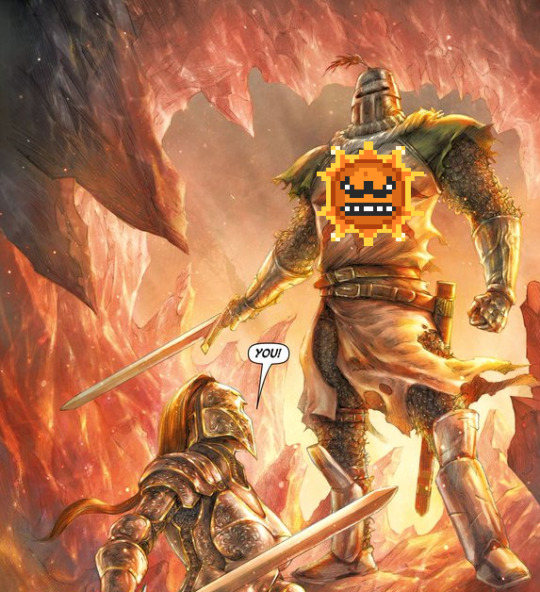
My stance on Dark Souls 3 is likely well known at this point: it's kind of a bummer. The two DLC packages, Ashes of Ariandel and The Ringed City, are in particular rather dire, but after some reflection, I think that the thing that really just rubs me the wrong way about the third installment is how it largely disavows that 2 ever happened. My stance on Dark Souls 2 is probably even more well known by now: it's actually a masterpiece of interactive fiction. Naturally, the fact that 3 likes to pretend that it doesn't exist is distressing to me. Now, especially with Ringed City, there are some concrete references to 2's world. The mysteriously flammable windmill of Earthen Peak and the sexy desert pyromancer outfit feature prominently in the Dreg Heap, the first miserable area of the Ringed City where screaming angels rain holy death upon you nonstop until you find their hidden summoners. Lapp, an NPC you meet here, is going hollow, and seeks the purging monument to restore his fading memories, which pays some lipservice to the powerful themes of loss of identity and self present in the second game but is otherwise completely absent in 3's narrative. These offerings come too little, too late to avert a very considerable gap between the cosmology and thematic elements of the two games.
Let's start with Hollowing. Hollowing is the process by which the undead, over the course of many deaths over the endless march of years, gradually lose themselves to the curse of the Darksign. Hollowing is an important element of Dark Souls 1, and utterly crucial to the story of 2. The process is almost absence in 3. Hollows still exist, but their role in things is alarmingly different. The player character doesn't hollow on death naturally. It's a mechanic that only appears if you do the Londor sidequest and Yoel draws out your "true strength" and manifests the dark sigil. Londor is apparently an entire nation of hollows, with advanced religious institutions and pilgrimages and fancy rings and purging stones to keep the hollows mostly functional. The entire idea of this, has, from the outset, struck me as absurd. There's no possible way that a nation of hollows could function at all in the paradigm of dark souls 1 and 2, because it would be a nation of people who do not even recognize themselves or society at large. The introduction of quick fixes to the problem of hollowing can be written off narratively with retcons to old information and allowed for with the changing, decaying state of the world, but it will never be graceful, and there is no way to reconcile these developments thematically. The desperate search to find a way to stave off hollowing defined some of my favorite characters in 2, like Lucatiel and Vendrick, but evidently you can just rub some purging stones on your face and you'll last to the damn end of the world. It doesn't even make sense in context of Dark Souls 1, where the way to restore yourself was with pillaged Humanity. It feels, in a way, oddly disrespectful to what came before, which is especially strange for a game like Dark Souls 3 that is so chock-full of desperate callbacks and recycled material.
This brings us to another stark contrast between 2 and 3: 2 was fiercely its own thing. It was its own thing to the point that people (myself included, for a time) felt that it was too different from one, that there weren't enough callbacks to the first game. In the end, though, this individuality was what really endeared me to Dark Souls 2. It took the framework from 1 and expanded upon the world and cosmology in a thoughtful, creative way that allowed it to be a game all its own. 3 is like ridiculously not that. 3 lives and dies by its fan pandering, callbacks, and slavish devotion to the order that 1 put forth. This is completely and utterly encapsulated by the two DLC packages, which both take place in worlds that are ripped straight from 1 (and 2). Ariandel is another painted world, filled with references to the first and Priscilla. The Dreg Heap is literally an amalgamation of all the works of man, dragged to the end of the world, and the ringed City is a reskin of Anor Londo, right up to housing a Large Girl Holding it All Together that you can kill to make everything 5000x worse. The bosses are The Last Two Demons, Another Fucking Slog of a Dragon Fight, the Old Monk, and Martyr Artorias. There are no new ideas here. Like, alarmingly so. The chestnut the game dangles in front of you is the mystery of the Dark Soul of Man and the pygmy lords, but, it's actually really hard to care about. I've done this all before, and done it better. Certainly, there's metatextual weight to this sensation due to how everything sort of smooshes together at the apocalypse, but it doesn't outweight how stale it all feels anyway.
Following from this might be my biggest observed discrepency: how 2 and 3 treat the cycle of fire and dark. In 3, the cycle has a definite end in the god danged End of the World, Fire Goin' Out, All Becomes Dust sense. 2, however, proposes a cycle that is well and truly endless, as a sort of karmic constant of the universe. The nature of 2's world is purgatorial, a divine punishment upon those who were self-important enough to deem themselves gods that the rest of us got caught up in. Gwyn and his cohorts are forgotten by the march of time, replaced by new gods, who are then themselves lost and replaced, forevermore. The soul of the ineffable reincarnates Gwyn, Seath, Nito, and the Witch for all eternity, doomed to repeat their mistakes in different forms over and over. Fire and Dark are the same, and one cannot exist without the other. This is entirely in line with the principles laid out in the opening sequence of the entire series: fire created disparity. Dark did not exist before fire. Dark Souls 3, however, takes a different direction entirely, and the Abyss becomes an entity seemingly outside of this dichotomy. At least, according to the locust preachers. They could be full of it. The game does call them out on being an unruly lot who only think about their stomachs. "Where fire resideth, shadows twist and shrivel. But in the Abyss, there are shadows none. Fear not, the dark, my friend." is the line I'm thinking about, which implies the Abyss is some sort of Ur-Darkness that can exist without contrasting light. Either way, there's a lot of contradictions between these two cosmological paradigms. Another example of this is how in Dark Souls 3, the old gods of Lordran are still a big deal, with like three different Divine Cities of Wonder squirreled away where agents of the old aristocracy still venerate Gwyn's Great and Mighty Sunlight Penis. Part of this seems to be a lack of original ideas to draw from, but it also betrays a cosmological bias towards the finders of the First Flame. The difference in the way that the universe treats Gwyn and company in Dark Souls 2 and 3 is a huge part of what drives them apart as narratives that can coexist in the same universe.
Aldia, Scholar of the First Sin, and all around Guy Who Knows About Stuff, seems to have the right of it. One of the major points of Dark Souls 2 was the futility of the first game's ending choice. Whether one links the fire or leaves it to fade does not matter within this eternal cycle. If linked, the flame will always fade again. If left to gutter, someone will always come along to stoke the fire once more. Mankind's "true shape", as posited by Vendrick, will never be realized because of the interference of fearful gods. Humans were descended of the Dark Soul, the soul that stands in contrast to the brilliant energies of light and fire that Gwyn, Nito, and the Witch found, and the gods hated it. They felt it was a threat, and so went against the natural order of things to prolong their own age of fire and used their fantastic power to curse humanity with transient forms. The most powerful lines in the series are delivered by Aldia: "No matter how tender, how exquisite, a lie will remain a lie." By his estimation, there are but two paths: inherit the order of this world, or destroy it. He is not referring to linking the fire or embracing the dark, because he knows that those are the same thing. To destroy the order of the world is to overcome the curse, to transcend it, to render the ultimatum of the gods ineffective. Gwyn's meddling left humanity with the choice of either continuing his vainglories to stave off Hollowing, or to defy him and become detestable creatures of the dark without self or identity. Aldia staked everything he had on finding a way to remove the curse, and ultimately lost it all in his endeavors. What those were are a matter for another time, but if you're asking, I think he tried to create another First Flame like the witch did. Honestly, I think he met with more success than the Witch of Izalith, because at least he didn't create a demon race, and he does seem to be beyond the curse.
The second ending of Dark Souls 2 is one which is available if you do all the DLC and collect the crowns of the kings, and speak to Vendrick in his memory. By collecting the crowns of true and almost true monarchs, you accumulate enough power in the crowns to overcome the Curse of Life. You don't cure or remove it, but by wearing one of the crowns, you become immune to hollowing. You can die as many times as you can imagine, and still retain your sense of self. The cycle of fire and dark is an allegory to the Buddhist concept of Samsara: death and rebirth. However, it is not a total transplantation. It finds roots in Samsara and Nirvana, but in Souls 2, the end result of Nirvana is significantly different, perhaps unattainable. In Buddhist doctrine, the ultimate release from Samsara comes from the quenching of the three fires, or poisons, of passion, ignorance, and aversion, becoming a being of "no-self." Way smarter people than me have talked about this a lot and my analysis is extremely pedestrian, but the idea of no-self comes into conflict with the ultimate goal of removing hollowing: retention of self. The iconic line, "The Curse of Life is the Curse of Want", is a very Samsara-tastic sentiment, but ultimately, enlightenment in Souls 2 is more straightforward than in Buddhist doctrine, as beings of no-self are acknoweledged by scholars to be somewhat paradoxical concepts. I think I've gotten slightly off track here. But that's good! Games that give you a lot to think about are good. That's my opinion and you can put it on a t-shirt. OKAY LET'S MOVE ON, BACK TO THE SECOND ENDING.
What happens is that Aldia confronts you after Nashandra's defeat, not to actually stop you or really do you harm but to simply test your convictions. Do you embrace the lie, or do you use your insight and the power of the crowns to search for a different path? By leaving the room, you choose to search for something different, and Aldia's disembodied voice accompanies you and muses about the difficulties ahead. There is no path. Beyond the scope of light and the reach of dark, you'll have to make your own. It's an extremely uplifting and affecting conclusion to the game. It's imperfect. It's not enlightenment, exactly. We still seek an answer, insatiably, but it is a form of transcendence born of a deep dissatisfaction with the order of the world, a sort of affirmation that to yearn for something better is not evil. It's hopeful and melancholy at the same time, a powerful conclusion to a personal journey, and perhaps the start of another. The fate of the world may not have changed, but the fate of the bearer of the curse has, and there is value in that. The search for truth is what gives the truth meaning. The questions the game raises about what it means to be a "true monarch" are thought provoking and powerful, encouraging the player to reject traditional models of power and monarchy by throwing like all of the shade ever at most of the kings to have ever ruled in the world of Dark Souls. Vendrick did all of this amazing stuff with the power of his soul, but in the end, was too cowardly to amount to anything. Gwyn was a vainglorious liar afraid of his own shadow. The old Iron King built a fucking magma castle just because he could. The only king to not get roasted is the Old Ivory King, who sacrificed everything for the wellbeing of his subjects, which is what we come to understand as the duty of a True Monarch: to not take the easy, convenient path.
In Dark Souls 3 there is absolutely no mention of any of this like EXTREMELY IMPORTANT SHIT where there's an undead who DOESN'T GO HOLLOW AT ALL UMM??? and the apocalypse is encroaching on a world where apocalypse should have no real meaning. The world has already ended and been reborn countless times before this. Kingdoms rise and fall and only Straid of Olaphis seems to remember the ones that came before because he spent the long centuries as a dang rock. It's not just that it feels like Dark Souls 2 never happened. It's that for Dark Souls 3 to work at all, it -needs- to have never happened. A lot of this probably comes from the fact that different teams worked on these games with different visions, but I feel like it's really disrespectful for the returning Miyazaki team to just disregard the genuinely fantastic work the "B team" did. This is especially true when you consider that Souls 3 is, as stated, kind of a fuckin bummer my dudes. It gives off the distinct impression of a game that never really wanted to be made. It feels reluctant to show its true self, which is almost unheard of in the Souls series, which in all other instances has worn its own self on its sleeve since the very beginning. Even after all this time, I don't know what Dark Souls 3 is really trying to say. It stands in opposition to its own predecessors despite feeling the need to draw so much from them, and this dissonance is ultimately the final nail in the coffin. It's a shame it had to end like this, but it also feels somewhat inevitable after the response that Dark Souls 2 got from ~angry gamers~. I hope that whatever Miyazaki and his team work on next, they can put their all into without reservation, and in the meantime, other developers try their hands at the souls formula. I want more games like Salt and Sanctuary and Nioh! ...even if it does mean I have to put up with the occasional Lords of the Fallen.
8 notes
·
View notes